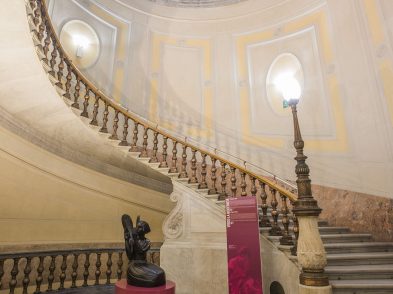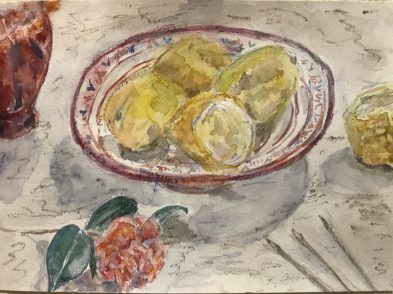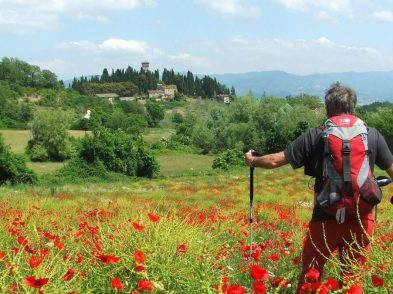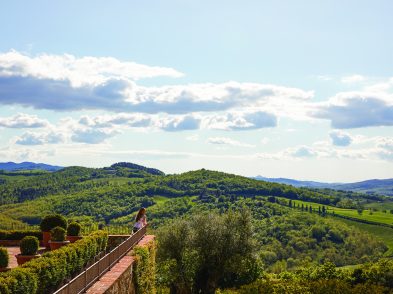It is just a 20-minute bus ride from the centre of Florence to the Pecci Museum of Contemporary Art in Prato, but a visit to the current retrospective of work by British artist David Tremlett will take you on a far longer journey. Paul Klee talked of ‘taking a line for a walk’—the art of drawing as an adventure allied to the process of thinking. It may not start with a preconceived idea, but the journey will somehow bring you the answer—or the journey becomes the answer itself.
Tremlett takes us on a journey across continents: Africa, India, Australia, the United States, Europe. As we retrace his steps, this collection invites us to experience the excitement of shifting perspectives that the physical and imaginative art of travel pro-vides. He does not provide us with ‘views’ of particular places, in the manner of 19th-century British travellers who would bring back watercolours of romantic ruins in Italy and Greece as souvenirs. The one series of ‘views’ present in the show has an en-tirely different overall effect: ‘The Cards’ is a work composed of 81 postcard-sized sketches of different counties in the British Isles, ranging from Scotland in the North to Kent in the South. They are placed side by side in a horizontal line that stretches across an entire wall, obliging the viewer to walk close beside them, replicating the movement of the artist as he may have trav-elled, walking and stopping to draw a field here and distant hills there.
Tremlett rose to prominence in the 80s with his site-specific wall drawings executed by hand on gallery walls, using pastel and graphite. These were sometimes intended to last. More often, however, they were drawn as ephemeral interventions in gal-lery spaces, lasting only for the length of an exhibition, after which they were painted over. This is what will happen to the five drawings that Tremlett has made on the walls of the Pecci museum. These new works create a dialogue with works from other moments in the artist’s career.
A significant feature of this retrospective is that it does not follow a chronological or thematic order. We can find conceptual works from the early 70s: ‘studies for movement,’ wherein sequences of photographs show changing facial expressions and dancing feet. In the same room, we can also appreciate more recent pastel drawings on paper, which serve as preparatory work for wall projects. Photographs of water form a sinuous shape against a wall; lines trace the movement of leaves in the wind in distant places or follow the flight of birds and shifting horizons; minimal words, place names and lists give a sense of distances travelled, of detail and universality.
The forms and textures in the wall drawings are echoed in photographs that focus on the shapes of empty windows and time-worn buildings in India and Africa. Collages and other exhibits superimpose colour sketches and travel memorabilia: postcards, tickets, photos, receipts, visas, phrasebooks, maps, messages, private view cards, and artist’s books all suggest inspiration for Tremlett’s work.
A pattern emerges: the works are about ways of looking and seeing, as the artist goes out into the world, roaming freely and at will. The paths he traces, the windows into other lives and cultures, are distilled in the wall drawings. Inside these drawings that same pursuit of freedom is expressed by the touch of the artist’s hand cutting into the space of the gallery. Tremlett alters our perception of that space through a kind of magic, the simplest of means: some pigment and graphite pressed, pushed and rubbed into walls with his fingers and palms, destined to last a few weeks. Our awareness of their transitory nature fundamen-tally affects our perception. Shakespeare’s Hamlet called man ‘a quintessence of dust’ after uttering one of the most enduring tributes to the wondrous nature of human existence: ‘What a piece of work is man!’ Tremlett makes us experience and value this paradox—a path on the boundary between fragility and solidity, the ephemeral and the enduring, where the most unassuming details celebrate the uniqueness of the moment.
David Tremlett. Retrospettiva 1969 – 2006exhibition continues until Jan. 7, 2007Centro per l’Arte Contemporanea Luigi Pecci Prato, Viale della Repubblica, 277Open every day except Tuesday 10am –7pmTel 0574 531828press@centropecci.it








